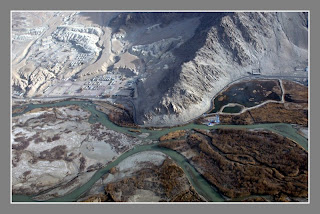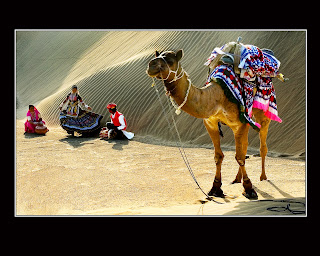Master of Peaks, Anup Sah
Photography for him is the finest medium of expression
amailto:anupsah@yahoo.co.in Phone: 09412084513 )
“It is the skill of a photographer which gives amazing results. No camera or lens can alone create good pictures.” This is what famous mountain photographer of the country, Anup Sah thinks. Anup Sah is known as master of peaks. He has been associated with mountain photography for a period of more than 20 years. His Himalayan Pictures have been used in a number of reputed books, numerous greeting cards and posters. Anup Sah has himself authored a few pictorial books of photography. He is a regular participant in national and international level photo-contests and has achieved more than 300 awards and 1700 acceptances in these contests. He has been honoured with Associateship Honour of India International Photographic Council, New Delhi. The same council has honoured him by giving Diamond Grade Honour also. He is active member of different mountaineering associations of the country. He has successfully completed various mountaineering expeditions. He is one of the active founders of Florists League, India. He has been a Member of the Uttarakhand Wildlife Advisory Board, Chaired by the Chief Minister of Uttarakhand. He was invited to China in 2006 for Pingyao International Photography Festival. He represented the delegation of Academy of Visual Media, New Delhi there. A simple and soft spoken human being, Anup Sah is always ready to click nature’s beauty with great zeal. He never hesitates to help and guide budding artists. Dr. Pankaj Sharma had a conversation with Anup Sah. Here are some parts of this conversation.
How did your photographic journey start?
As I was born in Nainital, I was deeply fascinated by the natural beauty of Uttarakhand since my childhood. I always wanted to capture the nature’s beauty in camera. My father, who was fond of photography, knew my interest and gifted me a camera (Agfa Isoly) in 1964. This added wings to my passion. I started clicking mountains. Initially I framed the pictures as my insight whispered. In those days there was no serious amateur in the field of photography in Nainital. There was a photo studio, named, Ratan Lal & Sons in my town. The owner of studio, on my request, taught me the basics of photography, i.e. composition, exposure, developing the film, making the prints etc. Later I came in contact of Col. Madhusudan ji, who was seriously associated with photography art. On his inspiration I, in 1985 participated in a national photography contest first time. Unfortunately all of my submitted photographs were rejected. But I did not feel disheartened and tried to improve my hand. In 1990 I had an opportunity to go for a trip to Kailash-Mansarovar. By now I had got a Nikon F-3 camera. I clicked a number of shots with great care during this trip. The same year I had a chance to project my images in a slide show in Moradabad. I was not aware of the presence of Great Master of photography art, Padmshree, Mr. T. Kashinath in this show. He, after the completion of slide show, met me and appreciated my pictures wholeheartedly. This moment was like a dream for me. On Mr. T. Kashinath’s suggestion I started participating in national level contests of photography seriously and never looked back.
What was the response of your family members towards your hobby?
My father and mother encouraged me since my childhood. They always appreciated me on my each success. In fact this is due to their blessings only that I have been able to take my hobby seriously. On the other hand my wife is also a source of inspiration for me. I find her with me at every step of success.
Who has worked as source of inspiration for you?
The work styles of Mr. Ansel Adams, Mr. O. P. Sharma, Mr. T. Kashinath and Kr. Shukdeo Singh have deeply fascinated and inspired me.
Apart from mountain-photography, which other branches of photography do you love?
I’m deeply interested in capturing wild life and flora. I like to click landscapes equally.
I think that pictorial value is the soul of every photograph. Whether it is a landscape or a wild life shot, I never compromise with pictorial quality of a picture.
What are your hobbies?
I’m a nature lover. Mountaineering and tracking are my passions. I have climbed various peaks of Uttarakhand and visited numerous remote places of the region. I regularly organise tracking tours. I have completed Traills Pass Expedition successfully in the year 1998. I have successfully completed the mountaineering expeditions of Nanda Devi, Nanda Khat, Panchchuli Peaks etc. On the other hand I’m seriously associated with horticulture. Colourful flowers have always attracted me.
Tell about your future plans.
I have to work a lot in the field of wild life of high altitude regions. Also I’m planning two books that will focus on Himalayan birds and animals.
Which equipments do you use?
I have a Nikon, D-80 camera. I have a sigma zoom lens of 10 mm to 20 mm which gives me dramatic results while shooting Himalayan landscapes. My other lenses are 24 mm to 75 mm zoom and a 75 mm to 200 mm zoom which I use as per the requirement. I use a Sigma telephoto lens of 500 mm for shooting wildlife. I’m very much satisfied with its results. But here I would like to add one thing - it is the skill of a photographer which gives amazing results. No camera or lens can alone create good pictures.
Where do young photographers stand in regard of their work?
Young artists are no doubt creating good pictures. They are much more updated with new technology in photo making. This is a good sign.
What message would you give to youth?
Today photography has made a vital place in the field of not only fine art but also in the field of employment. A skilled person in this art has a brightfuturwith a number of career options.









.jpg)

.jpg)



























